Synergism of Multi-Modal Data for Mapping Tree Species Distribution—A Case Study from a Mountainous Forest in Southwest China
Abstract
1. Introduction
2. Materials and Methods
2.1. Study Area
2.2. Data and Preprocessing
2.2.1. Features from Multi-Modal Data
2.2.2. Reference Samples
2.3. Design Data Cases and Feature Selection
2.4. Classification
2.4.1. Classification Model and Assessment
2.4.2. Overview of the Proposed Method
3. Results
3.1. Classification Results
3.2. Mapping of the Tree Species Classification Results
3.3. Feature Importance Assessment
4. Discussion
5. Conclusions
Author Contributions
Funding
Data Availability Statement
Acknowledgments
Conflicts of Interest
Appendix A
| Reference | |||||||||||
|---|---|---|---|---|---|---|---|---|---|---|---|
| PKV | OB | HB | EL | PY | QL | CL | BL | ACB | UA (%) | ||
| S2(SP) classification | PKV | 819 | 50 | 20 | 77 | 146 | 61 | 114 | 52 | 17 | 60.71 |
| OB | 61 | 738 | 78 | 35 | 14 | 258 | 31 | 98 | 36 | 53.82 | |
| HB | 5 | 70 | 736 | 7 | 7 | 28 | 17 | 14 | 4 | 82.05 | |
| EL | 13 | 9 | 1 | 631 | 10 | 5 | 10 | 22 | 2 | 90.40 | |
| PY | 122 | 14 | 1 | 18 | 516 | 55 | 16 | 9 | 49 | 62.69 | |
| QL | 78 | 97 | 2 | 14 | 41 | 188 | 16 | 36 | 42 | 38.47 | |
| CL | 22 | 14 | 17 | 10 | 16 | 16 | 339 | 18 | 13 | 72.71 | |
| BL | 20 | 46 | 0 | 24 | 10 | 31 | 18 | 228 | 17 | 57.07 | |
| ACB | 13 | 28 | 0 | 8 | 61 | 46 | 13 | 22 | 258 | 56.08 | |
| PA (%) | 71.03 | 69.23 | 86.08 | 76.57 | 62.85 | 27.32 | 55.48 | 45.69 | 58.90 | ||
| OA: 64.18% Kappa: 0.59 | |||||||||||
| Reference | |||||||||||
|---|---|---|---|---|---|---|---|---|---|---|---|
| PKV | OB | HB | EL | PY | QL | CL | BL | ACB | UA (%) | ||
| S2(SP+TX) classification | PKV | 836 | 59 | 14 | 56 | 171 | 79 | 69 | 38 | 13 | 62.48 |
| OB | 61 | 695 | 100 | 29 | 11 | 208 | 20 | 88 | 26 | 56.14 | |
| HB | 6 | 75 | 729 | 5 | 5 | 23 | 29 | 12 | 4 | 82.09 | |
| EL | 14 | 18 | 1 | 642 | 14 | 12 | 11 | 24 | 5 | 86.64 | |
| PY | 103 | 10 | 0 | 29 | 490 | 49 | 62 | 16 | 55 | 60.20 | |
| QL | 75 | 109 | 1 | 20 | 50 | 230 | 23 | 53 | 42 | 38.14 | |
| CL | 33 | 8 | 6 | 15 | 28 | 17 | 353 | 18 | 18 | 71.17 | |
| BL | 14 | 60 | 2 | 18 | 11 | 24 | 14 | 231 | 19 | 58.78 | |
| ACB | 11 | 32 | 2 | 10 | 41 | 46 | 30 | 19 | 253 | 56.98 | |
| PA (%) | 72.51 | 65.20 | 85.26 | 77.91 | 59.68 | 33.43 | 57.77 | 46.29 | 57.76 | ||
| OA: 64.11% Kappa: 0.59 | |||||||||||
| Reference | |||||||||||
|---|---|---|---|---|---|---|---|---|---|---|---|
| PKV | OB | HB | EL | PY | QL | CL | BL | ACB | UA (%) | ||
| S2(SP+TX+REP_TM) classification | PKV | 824 | 49 | 14 | 65 | 121 | 7 | 63 | 38 | 14 | 65.19 |
| OB | 63 | 732 | 64 | 30 | 14 | 245 | 35 | 97 | 32 | 57.50 | |
| HB | 4 | 60 | 764 | 2 | 6 | 15 | 10 | 6 | 2 | 87.72 | |
| EL | 17 | 17 | 1 | 658 | 9 | 8 | 3 | 15 | 3 | 88.56 | |
| PY | 113 | 21 | 1 | 20 | 564 | 45 | 52 | 10 | 56 | 63.66 | |
| QL | 78 | 115 | 3 | 18 | 36 | 223 | 13 | 23 | 46 | 41.97 | |
| CL | 27 | 14 | 5 | 8 | 20 | 14 | 400 | 20 | 15 | 73.49 | |
| BL | 11 | 28 | 2 | 14 | 4 | 14 | 13 | 275 | 18 | 75.33 | |
| ACB | 16 | 30 | 1 | 9 | 47 | 45 | 22 | 15 | 262 | 57.75 | |
| PA (%) | 71.47 | 68.67 | 89.36 | 79.85 | 68.70 | 35.32 | 61.70 | 57.52 | 58.68 | ||
| OA: 67.66% Kappa: 0.63 | |||||||||||
| Reference | |||||||||||
|---|---|---|---|---|---|---|---|---|---|---|---|
| PKV | OB | HB | EL | PY | QL | CL | BL | ACB | UA (%) | ||
| S2(SP+TX+REP_TM) + S1 classification | PKV | 870 | 46 | 12 | 72 | 60 | 86 | 65 | 32 | 15 | 69.16 |
| OB | 57 | 751 | 61 | 31 | 22 | 204 | 31 | 81 | 33 | 59.09 | |
| HB | 4 | 59 | 761 | 1 | 6 | 17 | 13 | 5 | 2 | 87.67 | |
| EL | 16 | 11 | 1 | 659 | 6 | 13 | 8 | 14 | 6 | 89.78 | |
| PY | 83 | 26 | 2 | 14 | 644 | 49 | 56 | 13 | 55 | 68.37 | |
| QL | 74 | 99 | 9 | 16 | 18 | 259 | 22 | 27 | 41 | 45.84 | |
| CL | 27 | 13 | 8 | 10 | 20 | 11 | 387 | 24 | 22 | 74.14 | |
| BL | 12 | 30 | 1 | 12 | 3 | 12 | 10 | 288 | 16 | 75.00 | |
| ACB | 10 | 31 | 0 | 9 | 42 | 18 | 18 | 15 | 248 | 60.49 | |
| PA (%) | 78.40 | 71.29 | 88.54 | 79.73 | 79.42 | 33.72 | 65.41 | 54.11 | 57.53 | ||
| OA: 69.99% Kappa: 0.66 | |||||||||||
| Reference | |||||||||||
|---|---|---|---|---|---|---|---|---|---|---|---|
| PKV | OB | HB | EL | PY | QL | CL | BL | ACB | UA (%) | ||
| S2(SP+TX+REP_TM)+S1 + Env classification | PKV | 987 | 55 | 8 | 128 | 5 | 105 | 23 | 45 | 14 | 74.52 |
| OB | 19 | 794 | 53 | 16 | 0 | 79 | 24 | 53 | 22 | 70.49 | |
| HB | 2 | 71 | 779 | 1 | 0 | 23 | 7 | 1 | 0 | 88.58 | |
| EL | 50 | 13 | 3 | 622 | 1 | 15 | 4 | 12 | 3 | 91.54 | |
| PY | 13 | 9 | 2 | 5 | 774 | 33 | 42 | 0 | 47 | 83.75 | |
| QL | 51 | 57 | 3 | 18 | 5 | 371 | 7 | 28 | 32 | 57.92 | |
| CL | 5 | 19 | 5 | 6 | 11 | 29 | 477 | 23 | 23 | 81.37 | |
| BL | 22 | 28 | 1 | 22 | 0 | 14 | 15 | 332 | 10 | 70.08 | |
| ACB | 4 | 20 | 1 | 6 | 25 | 19 | 11 | 5 | 287 | 65.12 | |
| PA (%) | 85.60 | 74.48 | 91.11 | 75.49 | 94.28 | 53.92 | 78.20 | 66.53 | 65.53 | ||
| OA: 77.98% Kappa: 0.75 | |||||||||||
| Cases | Selected Features | Number of Features (after vs. before) |
|---|---|---|
| S2(SP+TX+REP_TM) | ‘NDTI’, ‘NDSVI’, ‘REP’, ‘b_17_REP’, ‘b_4_REP’, ‘LSWI’, ‘B5_contrast’, ‘b_29_REP’, ‘MTCI’, ‘b_36_REP’, ‘B5_corr’, ‘IRECI’, ‘b_0_REP’, ‘B2’, ‘B4’, ‘TVI’, ‘b_19_REP’, ‘b_31_REP’, ‘B12’, ‘b_23_REP’, ‘B5’, ‘b_3_REP’, ‘b_34_REP’, ‘b_1_REP’, ‘NDWI’, ‘b_2_REP’, ‘B6’, ‘b_26_REP’, ‘NDRE1’, ‘b_13_REP’, ‘B5_shade’, ‘B3’. | 32/69 |
| S2(SP+TX+REP_TM) + S1 | ‘NDTI’, ‘NDSVI’, ‘REP’, ‘B2’, ‘b_18_REP’, ‘VV’, ‘LSWI’, ‘b_3_REP’, ‘b_22_REP’, ‘NDRE1’, ‘b_5_REP’, ‘B5_shade’, ‘NDI’, ‘B5_contrast’, ‘VH’, ‘b_0_REP’, ‘B12’, ‘MTCI’, ‘b_31_REP’, ‘B5_corr’, ‘b_12_REP’, ‘B5_savg’, ‘IRECI’, ‘B4’, ‘MCARI2’, ‘b_36_REP’, ‘TVI’, ‘B3’, ‘b_34_REP’, ‘b_29_REP’, ‘B6’. | 31/75 |
| S2(SP+TX+REP_TM) + Env | ‘NDTI’, ‘LST_5’, ‘elevation’, ‘LST_7’, ‘NDSVI’, ‘dec’, ‘LST_4’, ‘LSWI’, ‘REP’, ‘may’, ‘LST_9’, ‘b_5_REP’, ‘B2’, ‘jul’, ‘B5_corr’, ‘aspect’, ‘TVI’, ‘b_1_REP’, ‘LST_11’, ‘B11’, ‘jun’, ‘B5_contrast’, ‘b_11_REP’, ‘MTCI’, ‘LST_8’, ‘MCARI2’, ‘b_0_REP’, ‘feb’, ‘b_3_REP’, ‘NDRE1’, ‘nov’, ‘b_15_REP’, ‘apr’, ‘B5_shade’, ‘b_20_REP’ | 32/96 |
| S2(SP+TX+REP_TM) + S1 + Env | ‘NDTI’, ‘elevation’, ‘LST_7’, ‘LST_9’, ‘LST_5’, ‘NDSVI’, ‘dec’, ‘LST_8’, ‘LST_1’, ‘NBR’, ‘oct’, ‘REP’, ‘LST_6’, ‘TVI’, ‘VV’, ‘apr’, ‘may’, ‘b_1_REP’, ‘jul’, ‘b_27_REP’, ‘b_2_REP’, ‘b_7_REP’, ‘b_13_REP’, ‘b_3_REP’, ‘b_18_REP’, ‘b_36_REP’, ‘B4’, ‘b_23_REP’, ‘B2’, ‘B5’, ‘B5_contrast’, ‘NDRE1’, ‘B5_shade’, ‘b_25_REP’, ‘b_0_REP’, ‘NDWI’, ‘B12’, ‘b_10_REP’, ‘mRVI’. | 32/102 |
References
- Chiarucci, A.; Piovesan, G. Need for a global map of forest naturalness for a sustainable future. Conserv. Biol. 2020, 34, 368–372. [Google Scholar] [CrossRef] [PubMed]
- Xiao, J.; Chevallier, F.; Gomez, C.; Guanter, L.; Hicke, J.A.; Huete, A.R.; Ichii, K.; Ni, W.; Pang, Y.; Rahman, A.F.; et al. Remote sensing of the terrestrial carbon cycle: A review of advances over 50 years. Remote Sens. Environ. 2019, 233, 111383. [Google Scholar] [CrossRef]
- Bonan, G.B. Forests, climate, and public policy: A 500-year interdisciplinary odyssey. Annu. Rev. Ecol. Evol. Syst. 2016, 47, 97–121. [Google Scholar] [CrossRef]
- Graves, S.; Asner, G.; Martin, R.; Anderson, C.; Colgan, M.; Kalantari, L.; Bohlman, S. Tree species abundance predictions in a tropical agricultural landscape with a supervised classification model and imbalanced data. Remote Sens. 2016, 8, 161. [Google Scholar] [CrossRef]
- Adelabu, S.; Dube, T. Employing ground and satellite-based QuickBird data and random forest to discriminate five tree species in a Southern African Woodland. Geocarto Int. 2014, 30, 457–471. [Google Scholar] [CrossRef]
- Immitzer, M.; Atzberger, C.; Koukal, T. Tree species classification with random forest using very high spatial resolution 8-band worldview-2 satellite data. Remote Sens. 2012, 4, 2661–2693. [Google Scholar] [CrossRef]
- Pu, R. Mapping tree species using advanced remote sensing technologies: A state-of-the-art review and perspective. J. Remote Sens. 2021, 2021, 9812624. [Google Scholar] [CrossRef]
- Liu, Y.; Gong, W.; Xing, Y.; Hu, X.; Gong, J. Estimation of the forest stand mean height and aboveground biomass in Northeast China using SAR Sentinel-1B, multispectral Sentinel-2A, and DEM imagery. ISPRS J. Photogramm. Remote Sens. 2019, 151, 277–289. [Google Scholar] [CrossRef]
- Forkuor, G.; Dimobe, K.; Serme, I.; Tondoh, J.E. Landsat-8 vs. Sentinel-2: Examining the added value of sentinel-2’s red-edge bands to land-use and land-cover mapping in Burkina Faso. GIScience Remote Sens. 2017, 55, 331–354. [Google Scholar] [CrossRef]
- Hościło, A.; Lewandowska, A. Mapping forest type and tree species on a regional scale using multi-temporal sentinel-2 data. Remote Sens. 2019, 11, 929. [Google Scholar] [CrossRef]
- You, N.; Dong, J.; Huang, J.; Du, G.; Zhang, G.; He, Y.; Yang, T.; Di, Y.; Xiao, X. The 10-m crop type maps in Northeast China during 2017-2019. Sci. Data 2021, 8, 41. [Google Scholar] [CrossRef] [PubMed]
- Zeng, L.; Wardlow, B.D.; Xiang, D.; Hu, S.; Li, D. A review of vegetation phenological metrics extraction using time-series, multispectral satellite data. Remote Sens. Environ. 2020, 237, 111511. [Google Scholar] [CrossRef]
- Pasquarella, V.J.; Holden, C.E.; Woodcock, C.E. Improved mapping of forest type using spectral-temporal Landsat features. Remote Sens. Environ. 2018, 210, 193–207. [Google Scholar] [CrossRef]
- Sun, C.; Li, J.; Liu, Y.; Liu, Y.; Liu, R. Plant species classification in salt marshes using phenological parameters derived from Sentinel-2 pixel-differential time-series. Remote Sens. Environ. 2021, 256, 112320. [Google Scholar] [CrossRef]
- Htitiou, A.; Boudhar, A.; Lebrini, Y.; Hadria, R.; Lionboui, H.; Benabdelouahab, T. A comparative analysis of different phenological information retrieved from Sentinel-2 time series images to improve crop classification: A machine learning approach. Geocarto Int. 2020, 37, 1426–1449. [Google Scholar] [CrossRef]
- Hemmerling, J.; Pflugmacher, D.; Hostert, P. Mapping temperate forest tree species using dense Sentinel-2 time series. Remote Sens. Environ. 2021, 267, 112743. [Google Scholar] [CrossRef]
- Vuolo, F.; Ng, W.-T.; Atzberger, C. Smoothing and gap-filling of high resolution multi-spectral time series: Example of Landsat data. Int. J. Appl. Earth Obs. Geoinf. 2017, 57, 202–213. [Google Scholar] [CrossRef]
- Torres, R.; Snoeij, P.; Geudtner, D.; Bibby, D.; Davidson, M.; Attema, E.; Potin, P.; Rommen, B.; Floury, N.; Brown, M.; et al. GMES Sentinel-1 mission. Remote Sens. Environ. 2012, 120, 9–24. [Google Scholar] [CrossRef]
- Rüetschi, M.; Schaepman, M.; Small, D. Using multitemporal sentinel-1 C-band backscatter to monitor phenology and classify deciduous and coniferous forests in northern Switzerland. Remote Sens. 2017, 10, 55. [Google Scholar] [CrossRef]
- Tomppo, E.; Antropov, O.; Praks, J. Boreal forest snow damage mapping using multi-temporal sentinel-1 data. Remote Sens. 2019, 11, 384. [Google Scholar] [CrossRef]
- Liu, C.-a.; Chen, Z.-x.; Shao, Y.; Chen, J.-s.; Hasi, T.; Pan, H.-z. Research advances of SAR remote sensing for agriculture applications: A review. J. Integr. Agric. 2019, 18, 506–525. [Google Scholar] [CrossRef]
- Moreira, A.; Prats-Iraola, P.; Younis, M.; Krieger, G.; Hajnsek, I.; Papathanassiou, K.P. A tutorial on synthetic aperture radar. IEEE Geosci. Remote Sens. Mag. 2013, 1, 6–43. [Google Scholar] [CrossRef]
- Nasirzadehdizaji, R.; Balik Sanli, F.; Abdikan, S.; Cakir, Z.; Sekertekin, A.; Ustuner, M. Sensitivity analysis of multi-temporal sentinel-1 SAR parameters to crop height and canopy coverage. Appl. Sci. 2019, 9, 655. [Google Scholar] [CrossRef]
- Yang, Q.; Wang, L.; Huang, J.; Lu, L.; Li, Y.; Du, Y.; Ling, F. Mapping plant diversity based on combined SENTINEL-1/2 Data—Opportunities for subtropical mountainous forests. Remote Sens. 2022, 14, 492. [Google Scholar] [CrossRef]
- Lechner, M.; Dostálová, A.; Hollaus, M.; Atzberger, C.; Immitzer, M. Combination of sentinel-1 and sentinel-2 data for tree species classification in a central European biosphere reserve. Remote Sens. 2022, 14, 2687. [Google Scholar] [CrossRef]
- Dostálová, A.; Wagner, W.; Milenković, M.; Hollaus, M. Annual seasonality in Sentinel-1 signal for forest mapping and forest type classification. Int. J. Remote Sens. 2018, 39, 7738–7760. [Google Scholar] [CrossRef]
- Chiang, S.-H.; Valdez, M. Tree species classification by integrating satellite imagery and topographic variables using maximum entropy method in a Mongolian forest. Forests 2019, 10, 961. [Google Scholar] [CrossRef]
- Grzyl, A.; Kiedrzyński, M.; Zielińska, K.M.; Rewicz, A. The relationship between climatic conditions and generative reproduction of a lowland population of Pulsatilla vernalis: The last breath of a relict plant or a fluctuating cycle of regeneration? Plant Ecol. 2014, 215, 457–466. [Google Scholar] [CrossRef]
- Pearman, P.B.; Randin, C.F.; Broennimann, O.; Vittoz, P.; van der Knaap, W.O.; Engler, R.; Le Lay, G.; Zimmermann, N.E.; Guisan, A. Prediction of plant species distributions across six millennia. Ecol. Lett. 2008, 11, 357–369. [Google Scholar] [CrossRef]
- Amissah, L.; Mohren, G.M.J.; Bongers, F.; Hawthorne, W.D.; Poorter, L. Rainfall and temperature affect tree species distribution in Ghana. J. Trop. Ecol. 2014, 30, 435–446. [Google Scholar] [CrossRef]
- Deblauwe, V.; Droissart, V.; Bose, R.; Sonké, B.; Blach-Overgaard, A.; Svenning, J.C.; Wieringa, J.J.; Ramesh, B.R.; Stévart, T.; Couvreur, T.L.P. Remotely sensed temperature and precipitation data improve species distribution modelling in the tropics. Glob. Ecol. Biogeogr. 2016, 25, 443–454. [Google Scholar] [CrossRef]
- Baltzer, J.L.; Davies, S.J.; Bunyavejchewin, S.; Noor, N.S.M. The role of desiccation tolerance in determining tree species distributions along the Malay–Thai Peninsula. Funct. Ecol. 2008, 22, 221–231. [Google Scholar] [CrossRef]
- Xu, P.; Tsendbazar, N.-E.; Herold, M.; Clevers, J.G.P.W.; Li, L. Improving the characterization of global aquatic land cover types using multi-source earth observation data. Remote Sens. Environ. 2022, 278, 113103. [Google Scholar] [CrossRef]
- Zhou, W.; Liu, Y.; Ata-Ul-Karim, S.T.; Ge, Q.; Li, X.; Xiao, J. Integrating climate and satellite remote sensing data for predicting county-level wheat yield in China using machine learning methods. Int. J. Appl. Earth Obs. Geoinf. 2022, 111, 102861. [Google Scholar] [CrossRef]
- Ghosh, A.; Mishra, N.S.; Ghosh, S. Fuzzy clustering algorithms for unsupervised change detection in remote sensing images. Inf. Sci. 2011, 181, 699–715. [Google Scholar] [CrossRef]
- Schwenker, F.; Trentin, E. Pattern classification and clustering: A review of partially supervised learning approaches. Pattern Recognit. Lett. 2014, 37, 4–14. [Google Scholar] [CrossRef]
- Fassnacht, F.E.; Latifi, H.; Stereńczak, K.; Modzelewska, A.; Lefsky, M.; Waser, L.T.; Straub, C.; Ghosh, A. Review of studies on tree species classification from remotely sensed data. Remote Sens. Environ. 2016, 186, 64–87. [Google Scholar] [CrossRef]
- Lim, J.; Kim, K.-M.; Jin, R. Tree species classification using Hyperion and sentinel-2 data with machine learning in South Korea and China. ISPRS Int. J. Geo-Inf. 2019, 8, 150. [Google Scholar] [CrossRef]
- Xi, Y.; Ren, C.; Tian, Q.; Ren, Y.; Dong, X.; Zhang, Z. Exploitation of time series sentinel-2 data and different machine learning algorithms for detailed tree species classification. IEEE J. Sel. Top. Appl. Earth Obs. Remote Sens. 2021, 14, 7589–7603. [Google Scholar] [CrossRef]
- Gorelick, N.; Hancher, M.; Dixon, M.; Ilyushchenko, S.; Thau, D.; Moore, R. Google earth engine: Planetary-scale geospatial analysis for everyone. Remote Sens. Environ. 2017, 202, 18–27. [Google Scholar] [CrossRef]
- Hua, Z. The floras of southern and tropical southeastern Yunnan have been shaped by divergent geological histories. PLoS ONE 2013, 8, e64213. [Google Scholar] [CrossRef]
- Misra, G.; Cawkwell, F.; Wingler, A. Status of phenological research using sentinel-2 data: A review. Remote Sens. 2020, 12, 2760. [Google Scholar] [CrossRef]
- Park, J.-G.; Tateishi, R.; Matsuoka, M. A proposal of the Temporal Window Operation (TWO) method to remove high-frequency noises in AVHRR NDVI time series data. J. Jpn. Soc. Photogramm. Remote Sens. 1999, 38, 36–47. [Google Scholar] [CrossRef]
- Schafer, R.W. What is a Savitzky-Golay filter? [lecture notes]. IEEE Signal Process. Mag. 2011, 28, 111–117. [Google Scholar] [CrossRef]
- Gella, G.W.; Bijker, W.; Belgiu, M. Mapping crop types in complex farming areas using SAR imagery with dynamic time warping. ISPRS J. Photogramm. Remote Sens. 2021, 175, 171–183. [Google Scholar] [CrossRef]
- dos Santos, E.P.; da Silva, D.D.; do Amaral, C.H.; Fernandes-Filho, E.I.; Dias, R.L.S. A Machine Learning approach to reconstruct cloudy affected vegetation indices imagery via data fusion from Sentinel-1 and Landsat 8. Comput. Electron. Agric. 2022, 194, 106753. [Google Scholar] [CrossRef]
- Sarzynski, T.; Giam, X.; Carrasco, L.; Lee, J.S.H. Combining radar and optical imagery to map oil palm plantations in Sumatra, Indonesia, using the google earth engine. Remote Sens. 2020, 12, 1220. [Google Scholar] [CrossRef]
- Wan, Z.; Hook, S.; Hulley, G. MOD11A2 MODIS/Terra land surface temperature/emissivity 8-day L3 global 1km SIN grid V006. NASA LP DAAC: Greenbelt, MD, USA, 2015. [Google Scholar] [CrossRef]
- Brocca, L.; Filippucci, P.; Hahn, S.; Ciabatta, L.; Massari, V.; Camici, S.; Schüller, L.; Bojkov, B.; Wagner, W. SM2RAIN–ASCAT (2007–2018): Global daily satellite rainfall data from ASCAT soil moisture observations. Earth Syst. Sci. Data 2019, 11, 1583–1601. [Google Scholar] [CrossRef]
- Grabska, E.; Frantz, D.; Ostapowicz, K. Evaluation of machine learning algorithms for forest stand species mapping using Sentinel-2 imagery and environmental data in the Polish Carpathians. Remote Sens. Environ. 2020, 251, 112103. [Google Scholar] [CrossRef]
- Jia, J.; Yang, N.; Zhang, C.; Yue, A.; Yang, J.; Zhu, D. Object-oriented feature selection of high spatial resolution images using an improved Relief algorithm. Math. Comput. Model. 2013, 58, 619–626. [Google Scholar] [CrossRef]
- Zhang, N.; Chen, M.; Yang, F.; Yang, C.; Yang, P.; Gao, Y.; Shang, Y.; Peng, D. Forest height mapping using feature selection and machine learning by integrating multi-source satellite data in Baoding City, North China. Remote Sens. 2022, 14, 4434. [Google Scholar] [CrossRef]
- Li, J.; Cheng, K.; Wang, S.; Morstatter, F.; Trevino, R.P.; Tang, J.; Liu, H. Feature selection. ACM Comput. Surv. 2018, 50, 1–45. [Google Scholar] [CrossRef]
- Breiman, L. Random forests. Mach. Learn. 2001, 45, 5–32. [Google Scholar] [CrossRef]
- Hurtado, J.E. An examination of methods for approximating implicit limit state functions from the viewpoint of statistical learning theory. Struct. Saf. 2004, 26, 271–293. [Google Scholar] [CrossRef]
- Cai, L.; Wu, D.; Fang, L.; Zheng, X. Tree species identification using XGBoost based on GF-2 images. For. Resour. Wanagement 2019, 5, 44. [Google Scholar] [CrossRef]
- Persson, M.; Lindberg, E.; Reese, H. Tree species classification with multi-temporal sentinel-2 data. Remote Sens. 2018, 10, 1794. [Google Scholar] [CrossRef]
- Xie, B.; Cao, C.; Xu, M.; Duerler, R.S.; Yang, X.; Bashir, B.; Chen, Y.; Wang, K. Analysis of regional distribution of tree species using multi-seasonal sentinel-1&2 imagery within google earth engine. Forests 2021, 12, 565. [Google Scholar] [CrossRef]
- Ma, M.; Liu, J.; Liu, M.; Zeng, J.; Li, Y. Tree species classification based on sentinel-2 imagery and random forest classifier in the eastern regions of the Qilian mountains. Forests 2021, 12, 1736. [Google Scholar] [CrossRef]
- Ferreira, M.P.; Wagner, F.H.; Aragão, L.E.O.C.; Shimabukuro, Y.E.; de Souza Filho, C.R. Tree species classification in tropical forests using visible to shortwave infrared WorldView-3 images and texture analysis. ISPRS J. Photogramm. Remote Sens. 2019, 149, 119–131. [Google Scholar] [CrossRef]
- Lim, J.; Kim, K.-M.; Kim, E.-H.; Jin, R. Machine learning for tree species classification using sentinel-2 spectral information, crown texture, and environmental variables. Remote Sens. 2020, 12, 2049. [Google Scholar] [CrossRef]
- Brown, S.C.M.; Quegan, S.; Morrison, K.; Bennett, J.C.; Cookmartin, G. High-resolution measurements of scattering in wheat canopies-implications for crop parameter retrieval. IEEE Trans. Geosci. Remote Sens. 2003, 41, 1602–1610. [Google Scholar] [CrossRef]
- Wang, M.; Li, M.; Wang, F.; Ji, X. Exploring the optimal feature combination of tree species classification by fusing multi-feature and multi-temporal sentinel-2 data in Changbai mountain. Forests 2022, 13, 1058. [Google Scholar] [CrossRef]
- Brus, D.J.; Hengeveld, G.M.; Walvoort, D.J.J.; Goedhart, P.W.; Heidema, A.H.; Nabuurs, G.J.; Gunia, K. Statistical mapping of tree species over Europe. Eur. J. For. Res. 2011, 131, 145–157. [Google Scholar] [CrossRef]
- Toledo, M.; Poorter, L.; Peña-Claros, M.; Alarcón, A.; Balcázar, J.; Chuviña, J.; Leaño, C.; Licona, J.C.; ter Steege, H.; Bongers, F.J.B. Patterns and determinants of floristic variation across lowland forests of Bolivia. Biotropica 2011, 43, 405–413. [Google Scholar] [CrossRef]
- Wessel, M.; Brandmeier, M.; Tiede, D. Evaluation of different machine learning algorithms for scalable classification of tree types and tree species based on sentinel-2 data. Remote Sens. 2018, 10, 1419. [Google Scholar] [CrossRef]
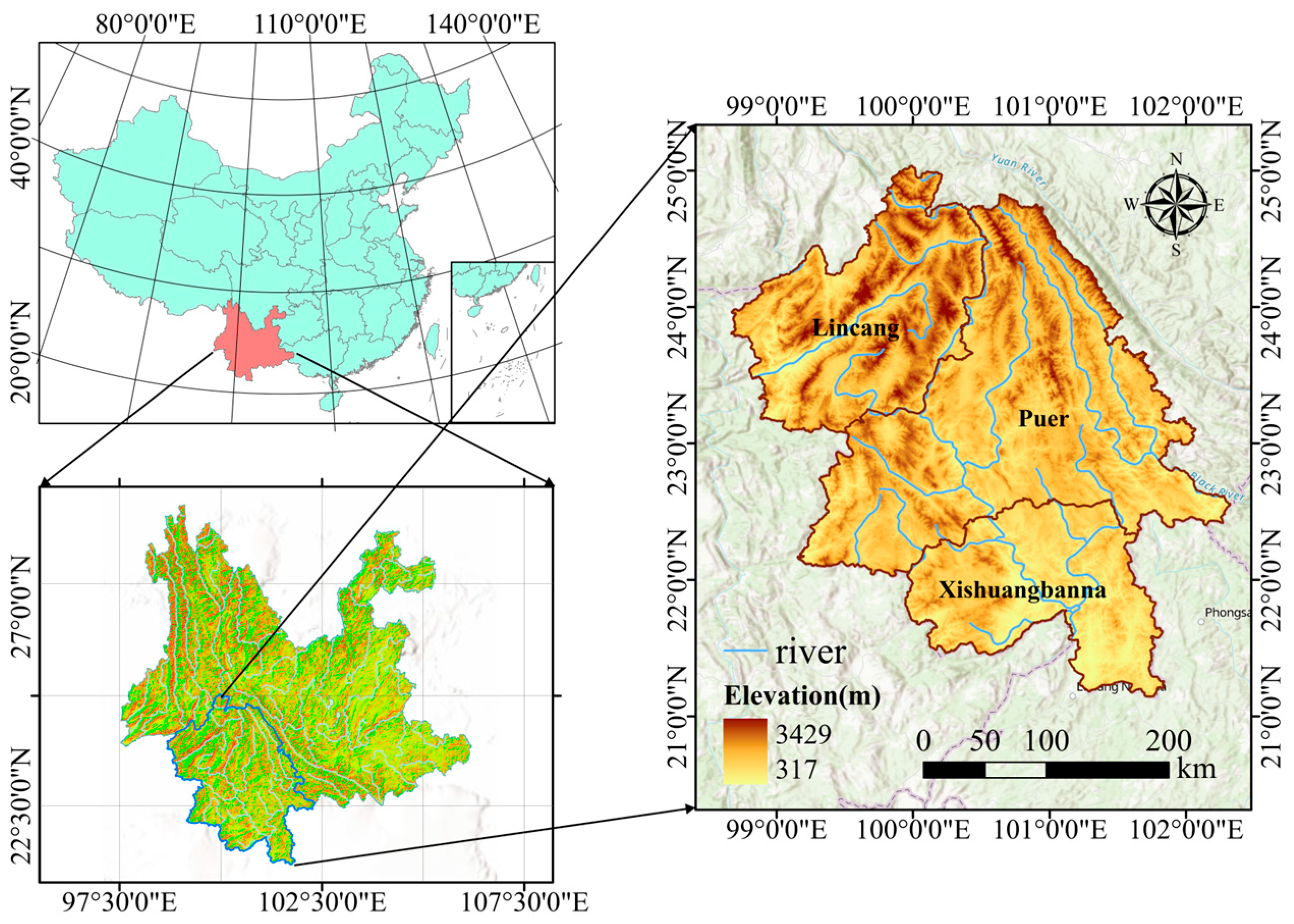
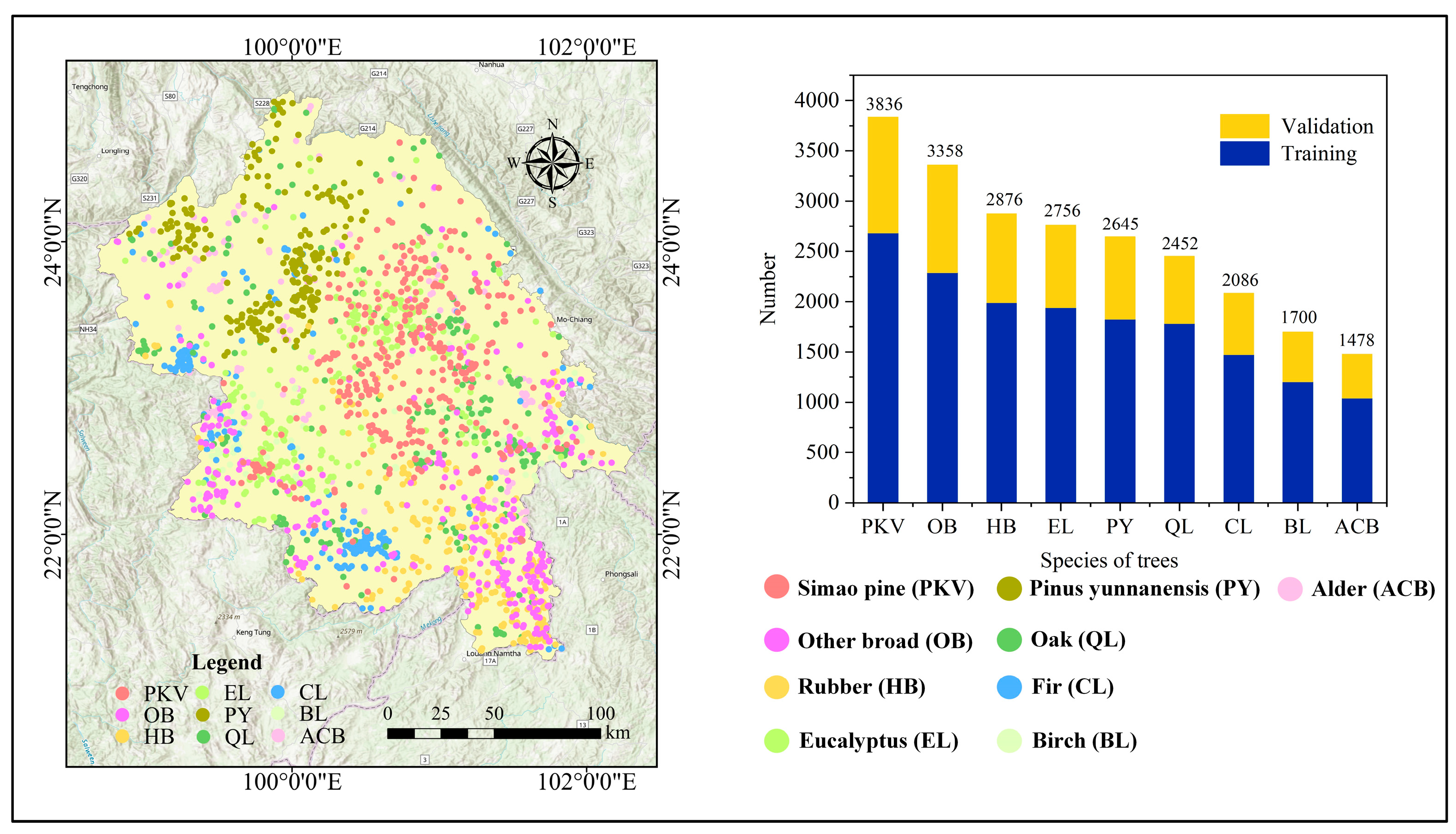
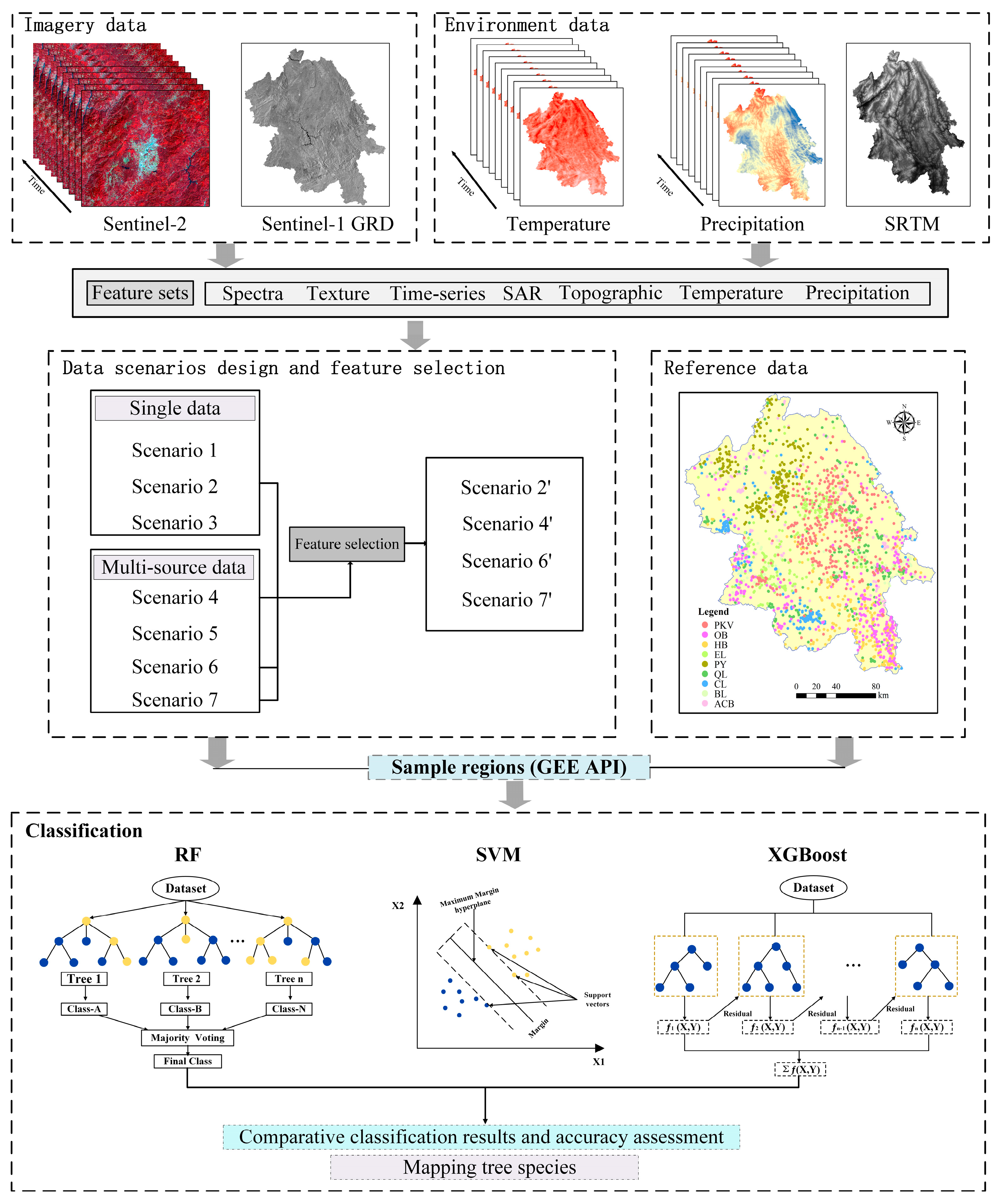
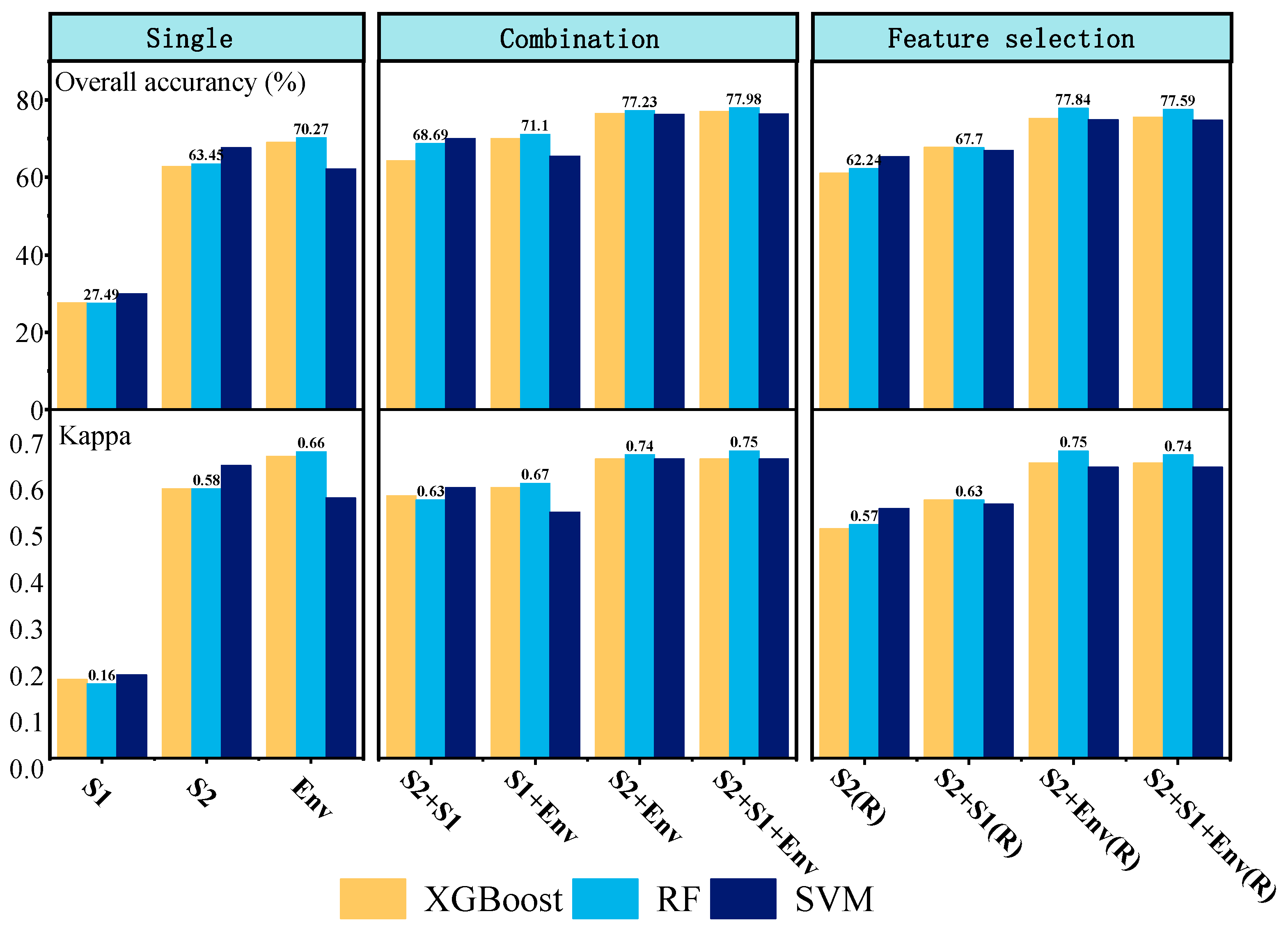
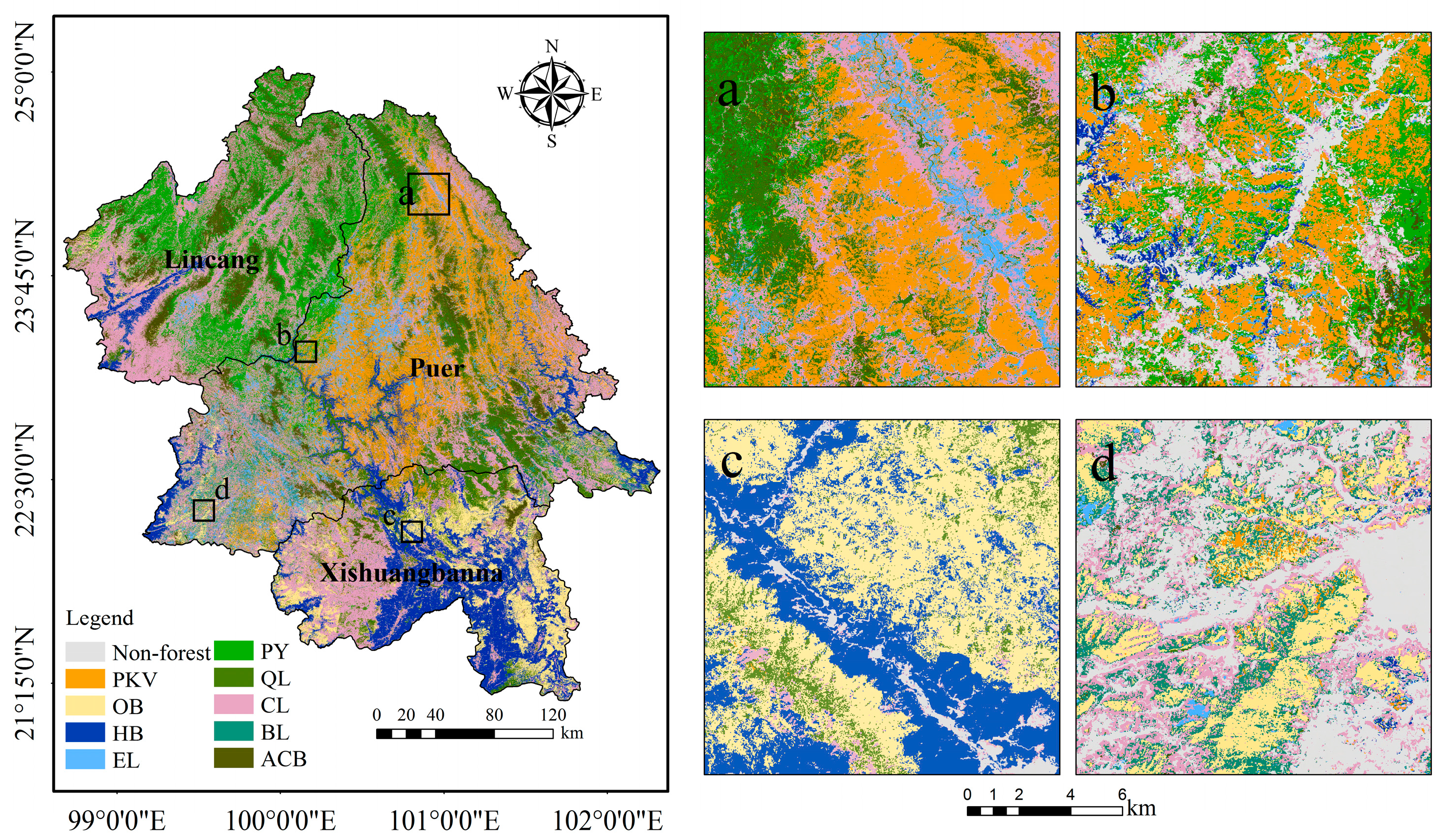
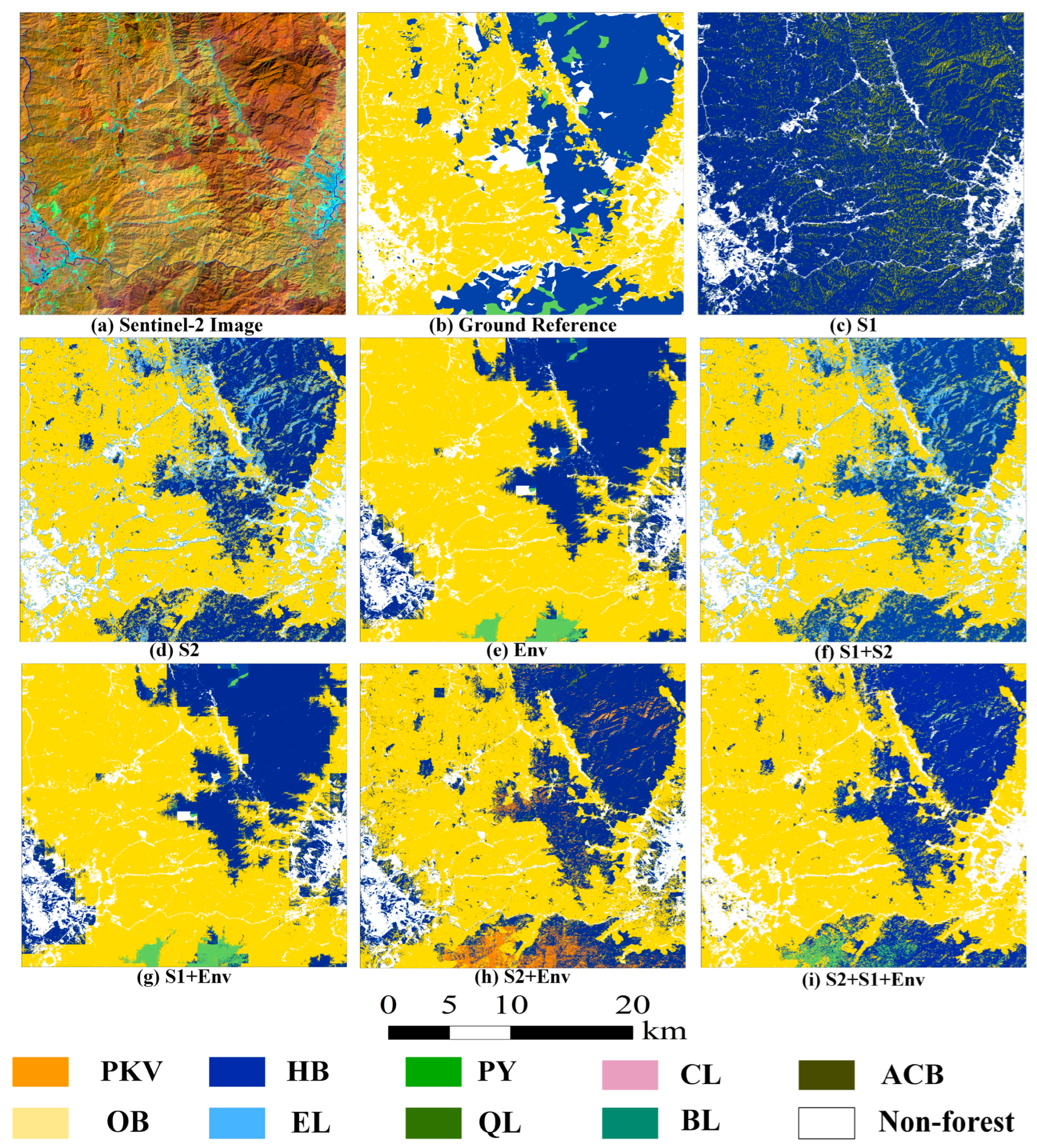
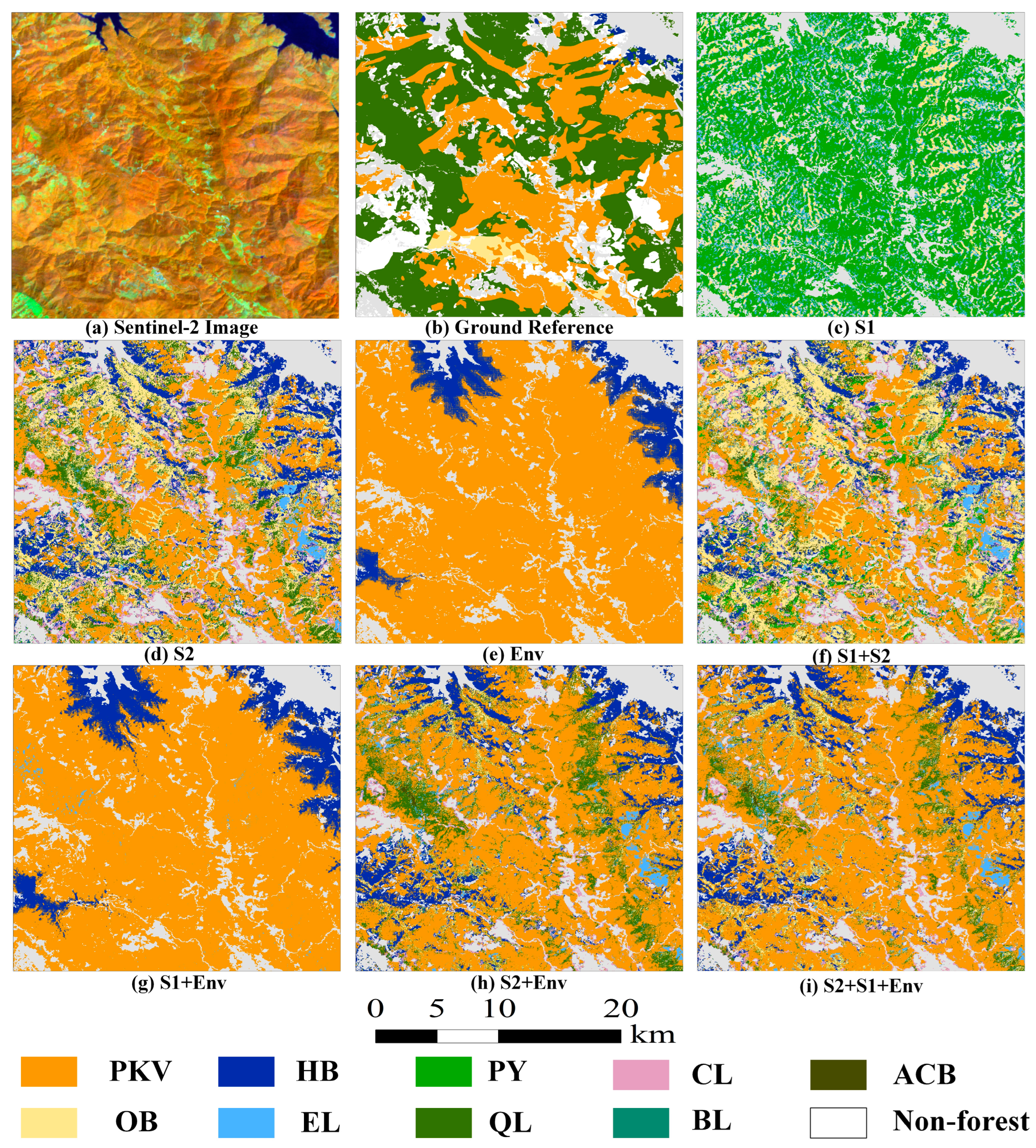
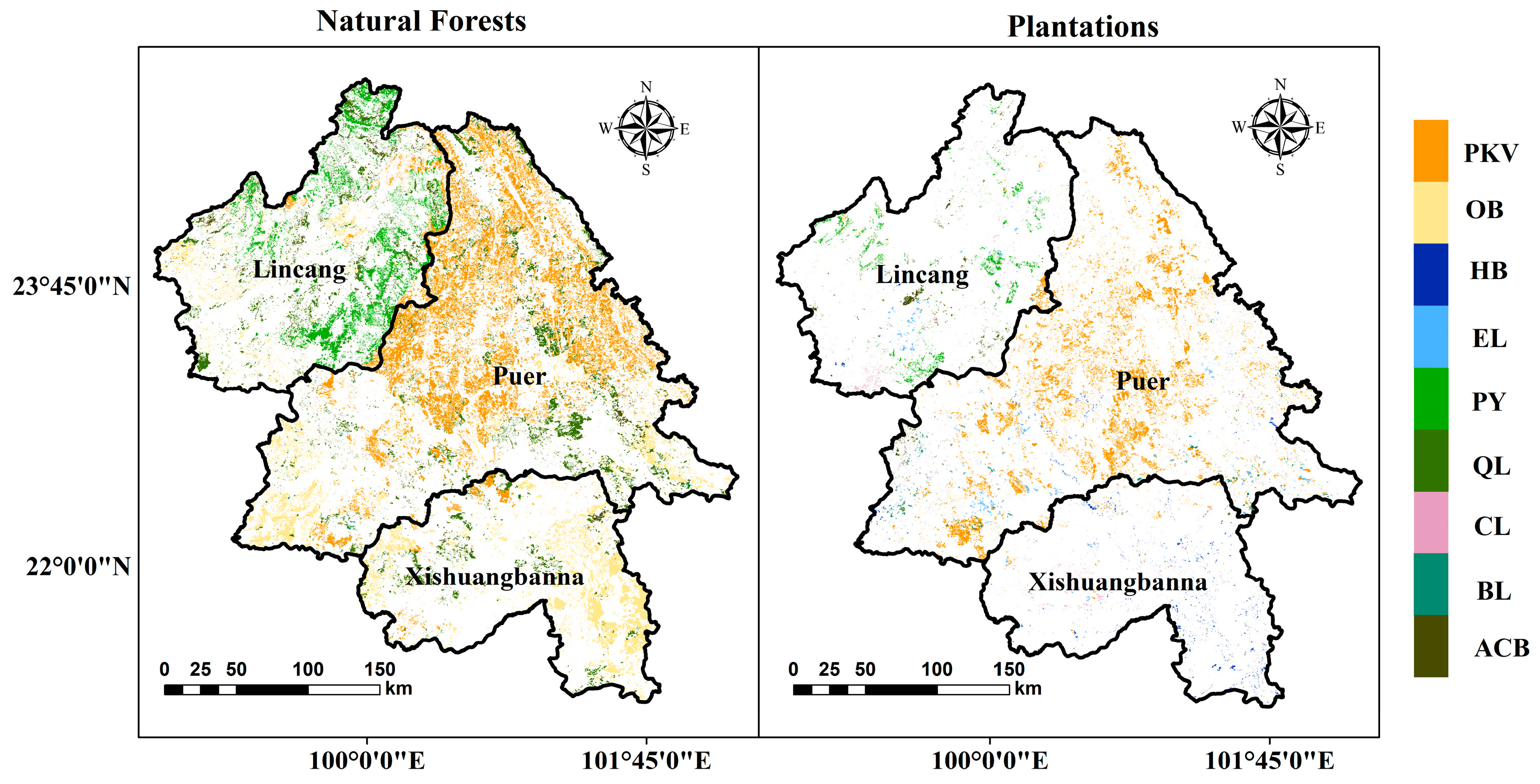
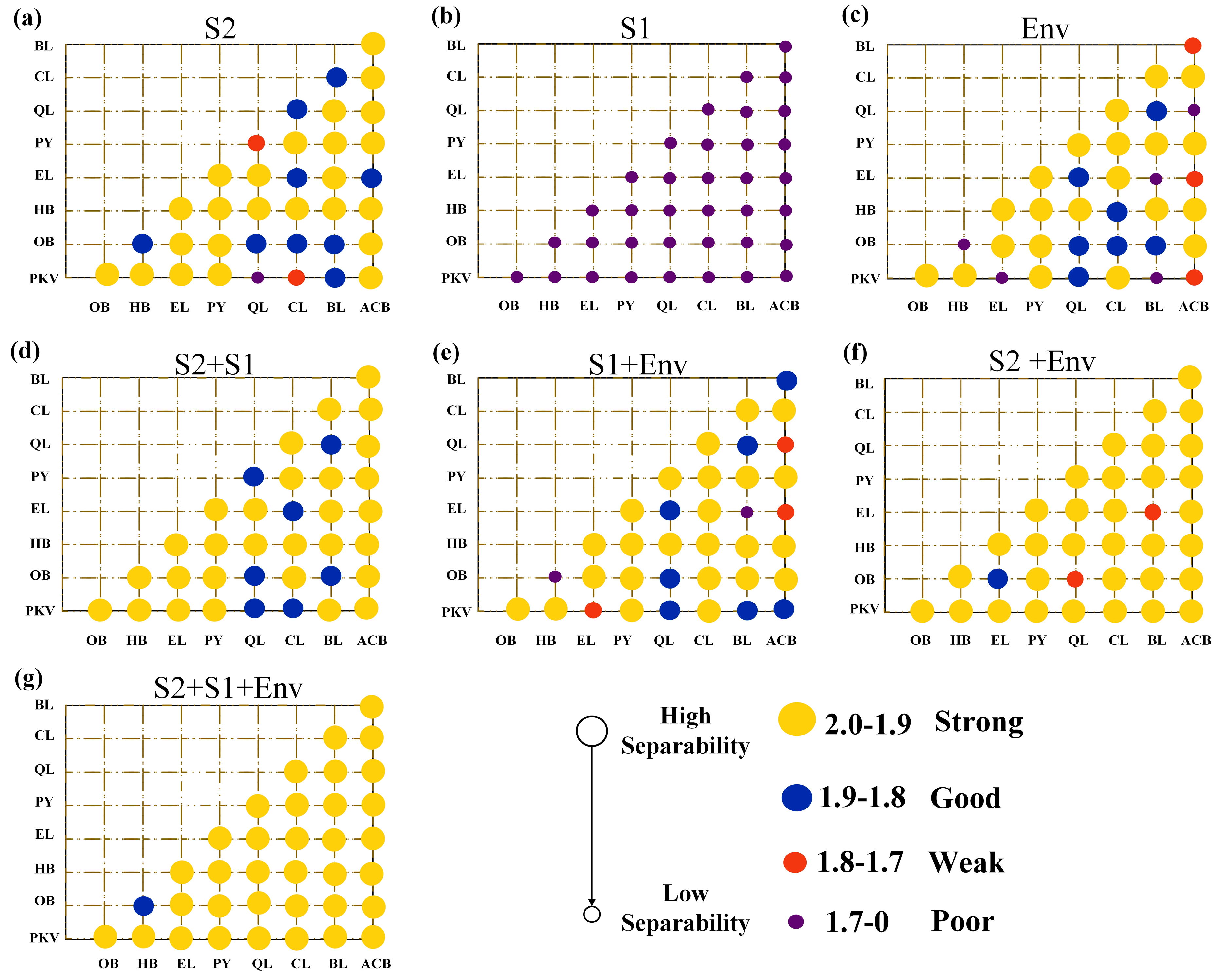
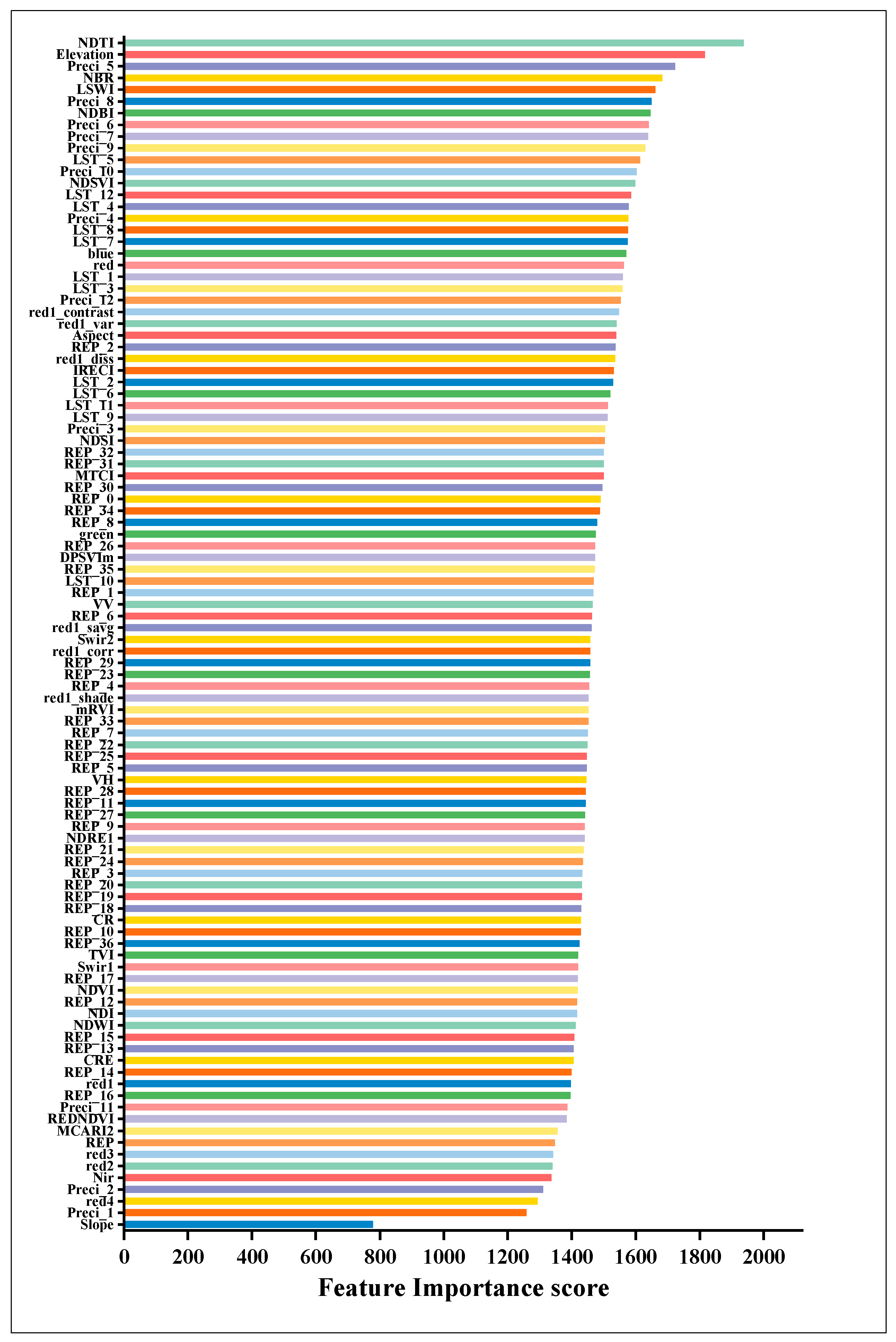
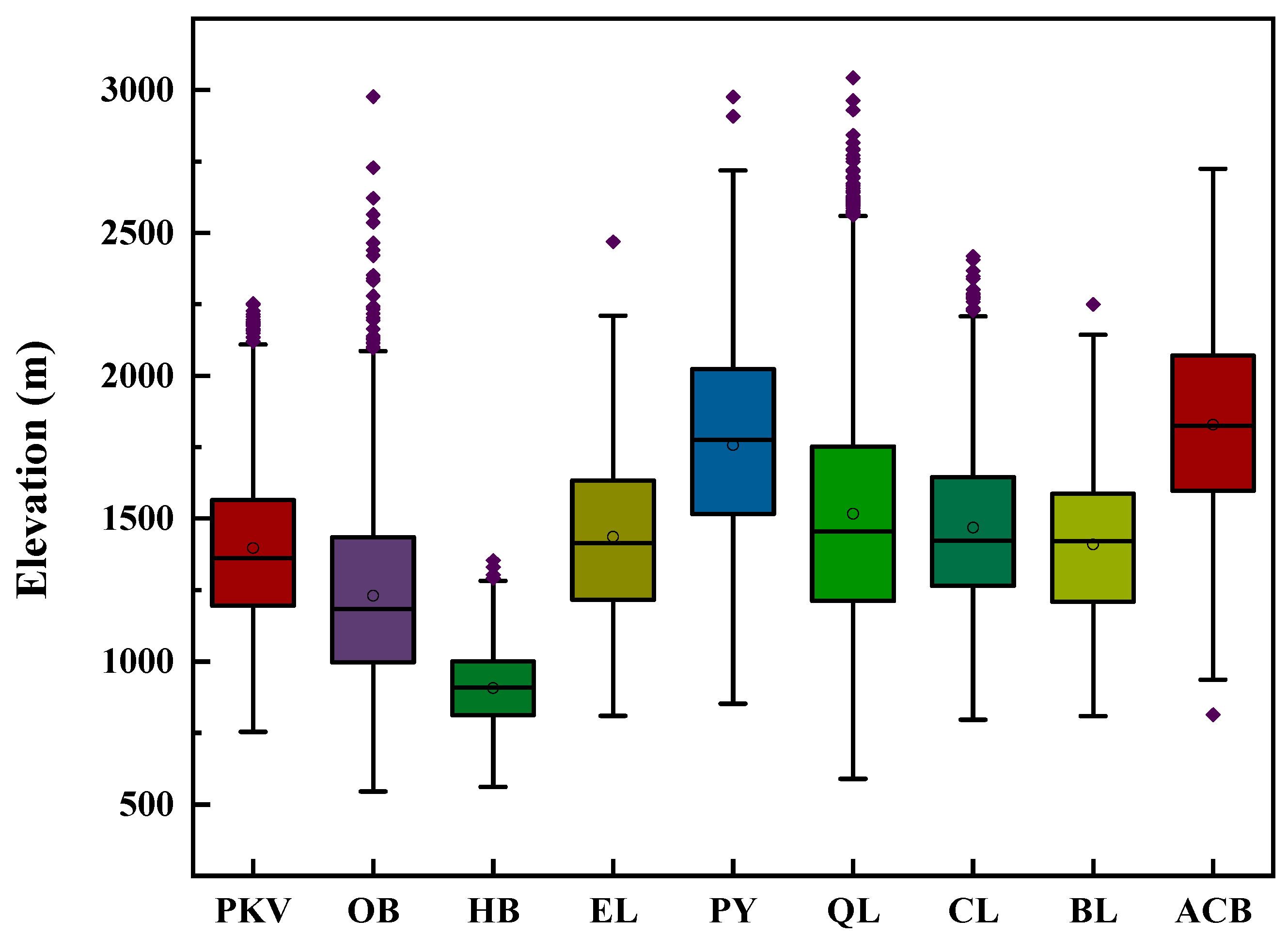
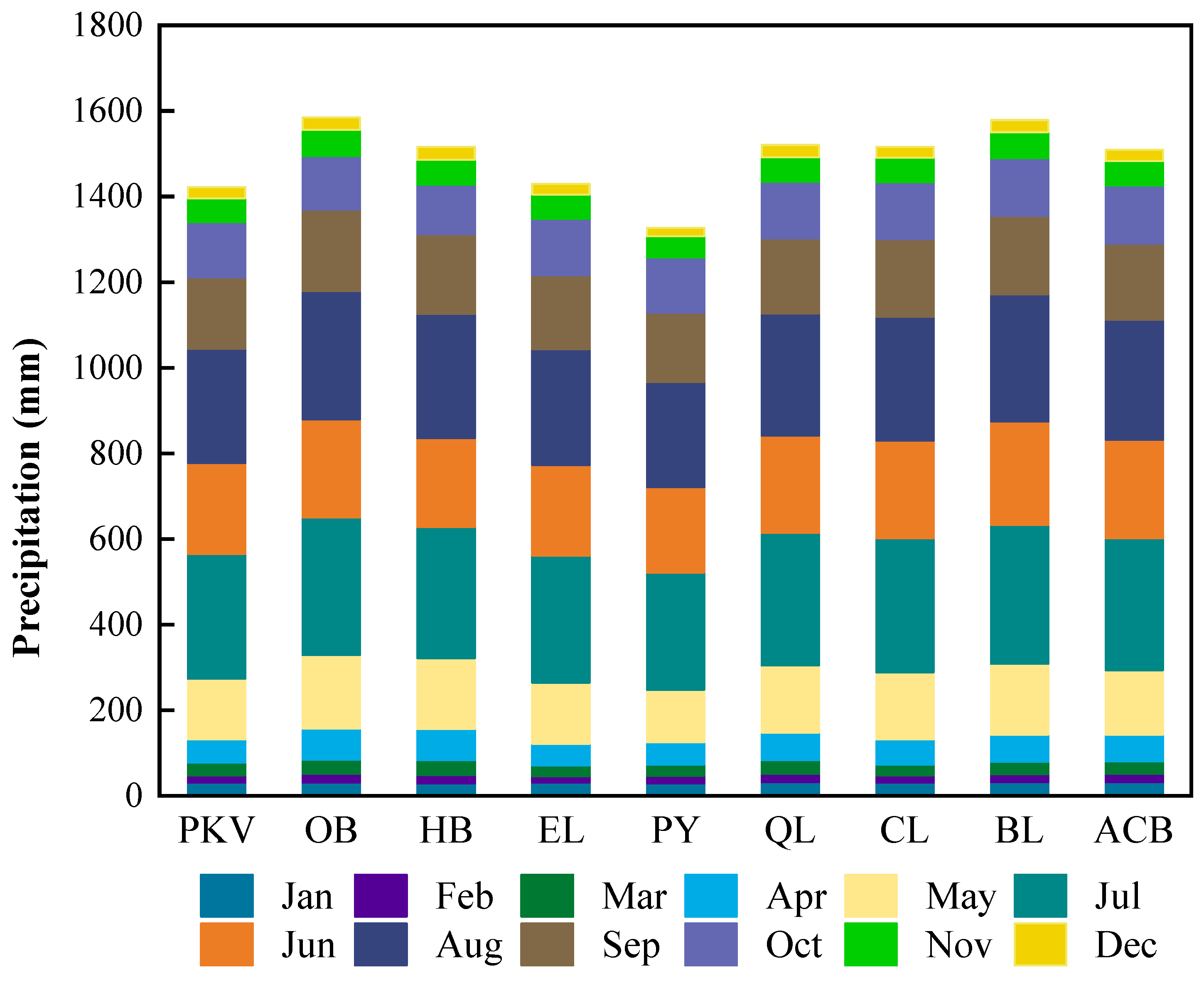
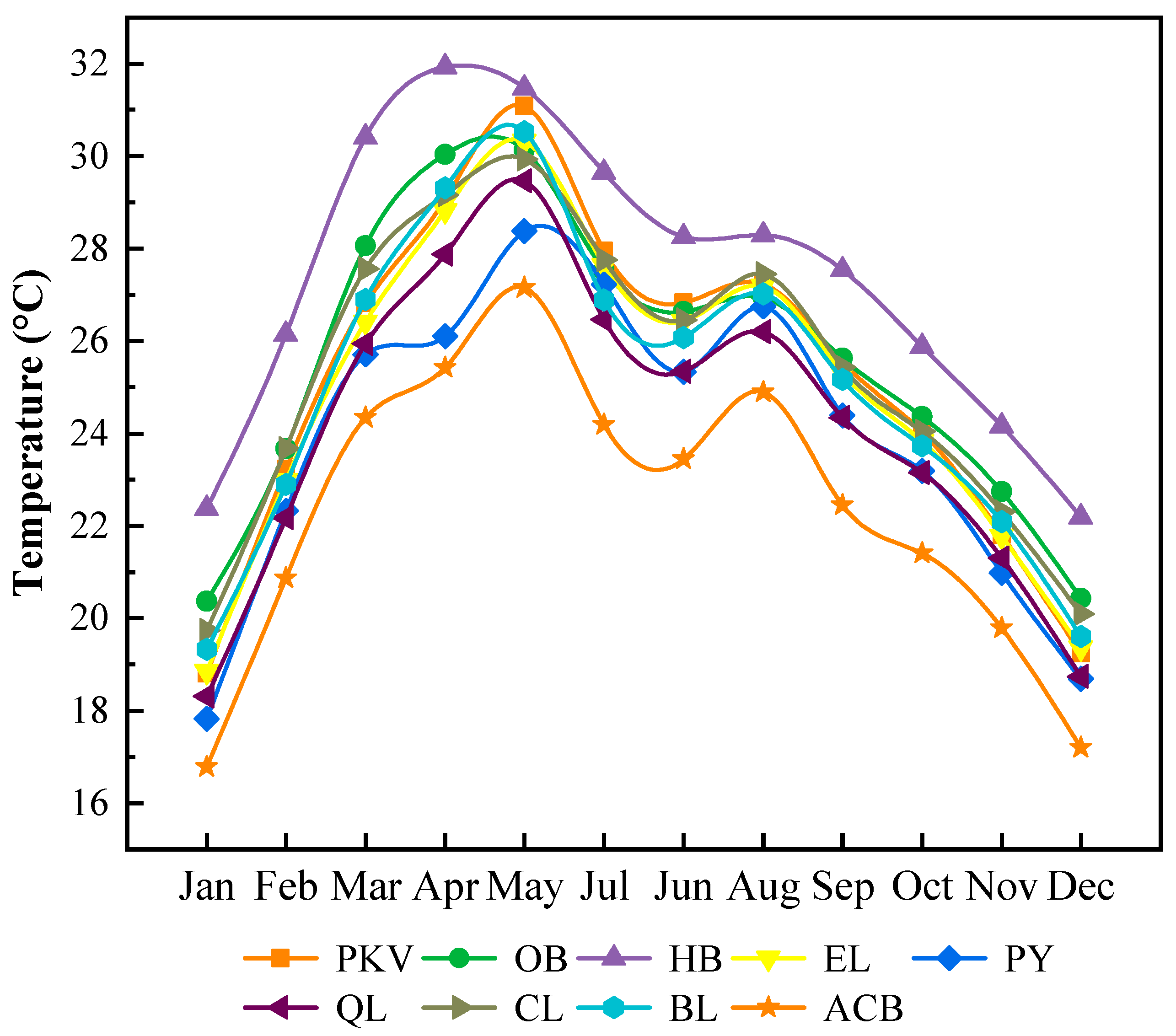
| Feature Number | Acronym | Description |
|---|---|---|
| Spectral (26) | SP | 10 basic Sentinel-2 bands (blue, green, red, red edge 4, NIR, SWIR 2). 16 vegetation indices |
| Texture (6) | TX | The red edge was selected to calculate 6 GLCM metrics: the sum average, correlation, dissimilarity, variance, contrast, and cluster shade. |
| REP_Time Series (37) | REP_TM | A 10-day time-series of the REP |
| SAR (6) | S1 | VV, VH, CR, and 3 radar vegetation indices: NDI, mRVI, and DPSVIm. |
| Environmental Factors (27) | Env | Topographic (elevation, slope, and aspect) Monthly mean precipitation Monthly mean land surface temperature |
| Serial Number | Abbreviation of Data Cases | Data Source | Number of Features |
|---|---|---|---|
| Cases 1 | S1 | Sentinel-1 | 6 |
| Cases 2 | S2(SP+TX+REP_TM) | Sentinel-2 | 69 |
| Cases 3 | Env | Topographic, temperature, precipitation | 27 |
| Cases 4 | S2(SP+TX+REP_TM) + S1 | Sentinel-1, Sentinel-2 | 75 |
| Cases 5 | S1 + Env | Sentinel-1, topographic, temperature, precipitation | 33 |
| Cases 6 | S2(SP+TX+REP_TM) + Env | Sentinel-2, topographic, temperature, precipitation | 96 |
| Cases 7 | S2(SP+TX+REP_TM) + S1 + Env | Sentinel-1, Sentinel-2, topographic, temperature, precipitation | 102 |
Disclaimer/Publisher’s Note: The statements, opinions and data contained in all publications are solely those of the individual author(s) and contributor(s) and not of MDPI and/or the editor(s). MDPI and/or the editor(s) disclaim responsibility for any injury to people or property resulting from any ideas, methods, instructions or products referred to in the content. |
© 2023 by the authors. Licensee MDPI, Basel, Switzerland. This article is an open access article distributed under the terms and conditions of the Creative Commons Attribution (CC BY) license (https://creativecommons.org/licenses/by/4.0/).
Share and Cite
Zheng, P.; Fang, P.; Wang, L.; Ou, G.; Xu, W.; Dai, F.; Dai, Q. Synergism of Multi-Modal Data for Mapping Tree Species Distribution—A Case Study from a Mountainous Forest in Southwest China. Remote Sens. 2023, 15, 979. https://doi.org/10.3390/rs15040979
Zheng P, Fang P, Wang L, Ou G, Xu W, Dai F, Dai Q. Synergism of Multi-Modal Data for Mapping Tree Species Distribution—A Case Study from a Mountainous Forest in Southwest China. Remote Sensing. 2023; 15(4):979. https://doi.org/10.3390/rs15040979
Chicago/Turabian StyleZheng, Pengfei, Panfei Fang, Leiguang Wang, Guanglong Ou, Weiheng Xu, Fei Dai, and Qinling Dai. 2023. "Synergism of Multi-Modal Data for Mapping Tree Species Distribution—A Case Study from a Mountainous Forest in Southwest China" Remote Sensing 15, no. 4: 979. https://doi.org/10.3390/rs15040979
APA StyleZheng, P., Fang, P., Wang, L., Ou, G., Xu, W., Dai, F., & Dai, Q. (2023). Synergism of Multi-Modal Data for Mapping Tree Species Distribution—A Case Study from a Mountainous Forest in Southwest China. Remote Sensing, 15(4), 979. https://doi.org/10.3390/rs15040979










